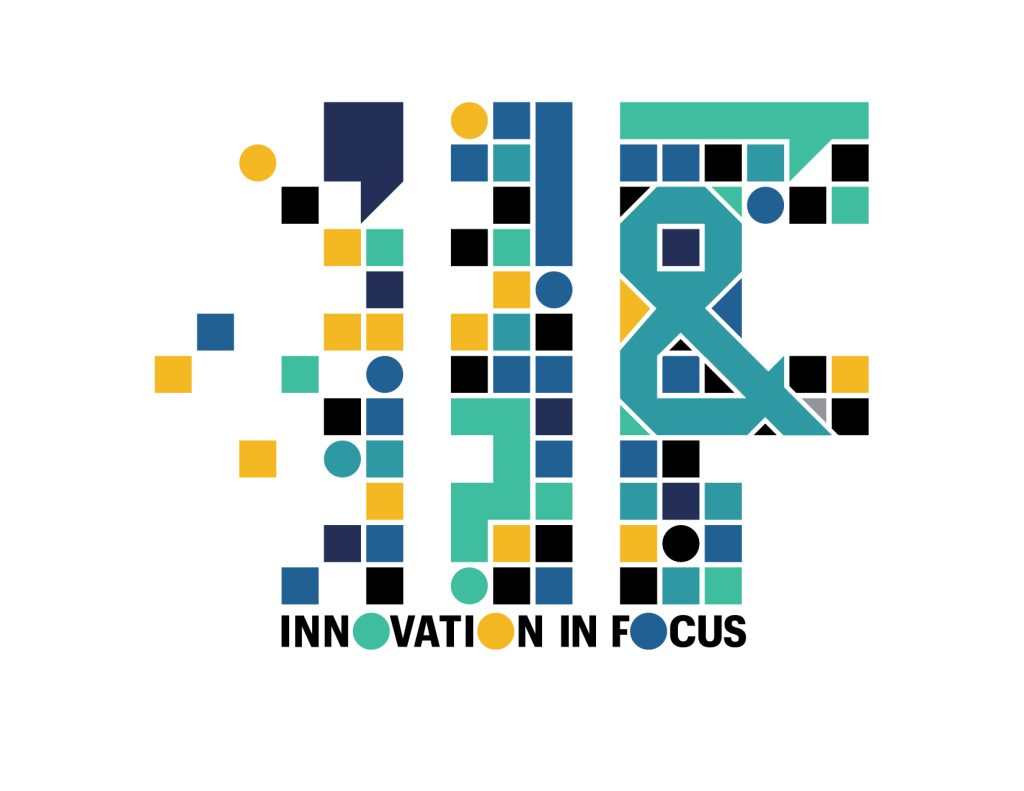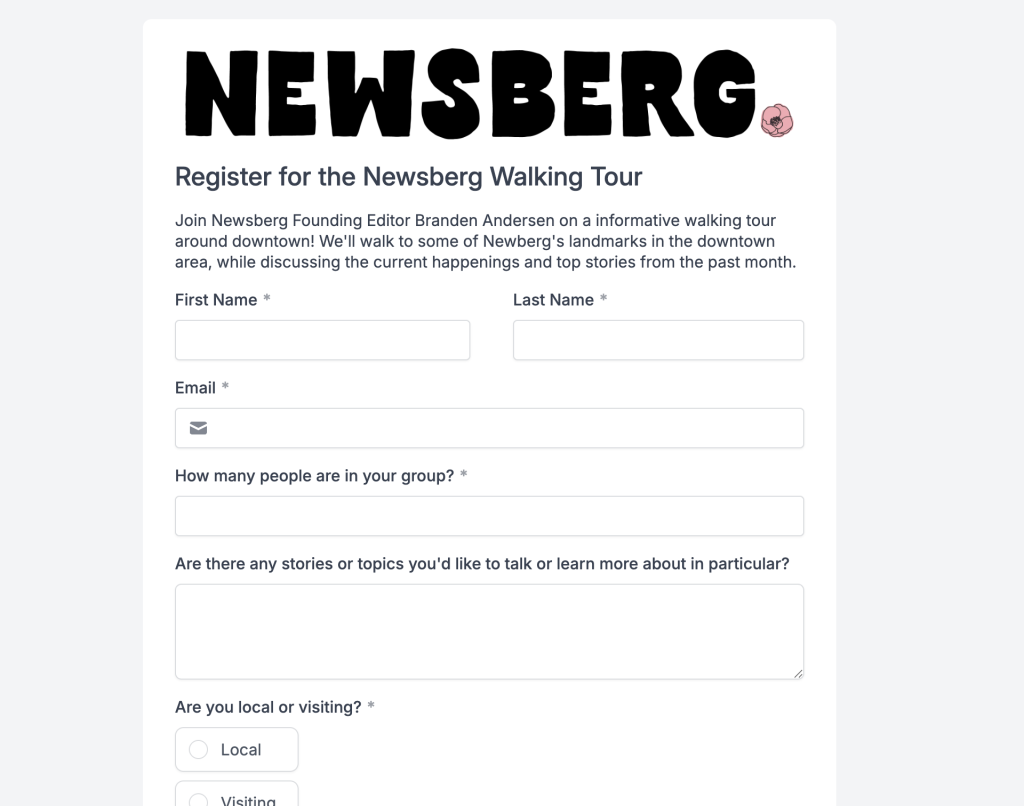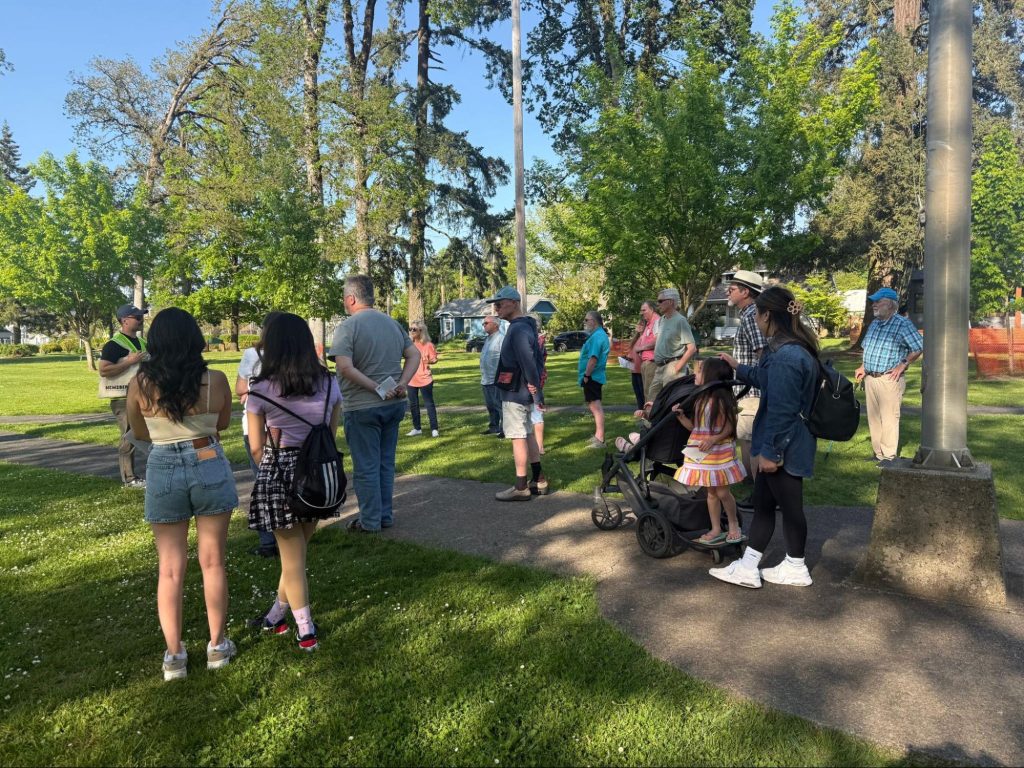
Newsberg’s founding editor, Branden Andersen, leads his first walking tour on May 1.
Connecting with communities through walking tours
How we implemented walking tours with Newsberg
In an increasingly digital media landscape, Branden Andersen, editor and founder of the independent Oregon media outlet Newsberg, wanted to connect with his audience in a personal way. After learning how Future Tides uses walking tours to spark community engagement, Andersen wanted to test this idea with his communities, which includes the small cities of Newberg and Dundee.
Working with Andersen, we launched Newsberg’s first walking tour on May 1, which the organization plans to continue on a monthly basis. Here are our top takeaways for planning, implementing and evaluating the success of walking tours.
Step 1: Why walking tours
As the founder of a young news organization, Andersen saw tours as a way to engage directly with his community and form a deeper connection than he could from behind a screen. This also came at a time when distrust in local news was high in his community, especially after AI-generated content took over an Oregon newspaper last year.
Tours are also a way to draw people back to Newsberg’s coverage. Andersen had seen previous success with creating coloring books and including QR codes to related stories, and we wanted to expand that idea into an in-person event.
Step 2: Look for inspiration
Some of the news and tour organizations that we reviewed before designing the Newsberg walking tours included:
Step 3: Plan the tour route
A few things we considered when mapping out the route:
- Will we stay on public property the entire time?
- Do we need any kind of permit or licensing from the city to do this walking tour?
- Accessibility: Is the tour located on mostly flat ground with accessible entrances to any buildings on the route? Are there rest points or places to sit down/stop along the way? Is the map accessible to everyone?
- Where is a central location to start each tour?
- Which locations have a tie to local news stories or history of Newberg?
- Which locations can we keep on each tour as a way to update attendees on local news? (For example, the city hall will be a good place for city government updates).
We decided to keep the tour under an hour and meet in a central location. Here is the map that Andersen created for the tour.

Step 4: Design a handout
We used Canva to design a physical 8.5 x 11-inch handout to give to tour participants because we wanted them to have a way to take notes and easily view the tour map. We also wanted to give people a branded souvenir to take away from the experience.
The design for the handout is based on a zine template from Mirror Indy. We really liked the way the template makes use of space and folds up to fit in someone’s pocket. Unfolded, the back of the handout displays the tour map.
We used the four quadrants to display information about the town and Newsberg’s journalism. We also left a quadrant open for notes.
How to make a zine or handout using this template
STEP 1: On one side of the 8.5 x 11-inch page, create quadrants for content. We used Canva.
Quadrants 1 & 2: We wanted our inside pages to complement each other since they open side-by-side. We included information about the town of Newberg and an “About” section for Newberg’s journalism.
Quadrants 3 & 4 (cover): We added lines to quadrant three for note-taking, and we designed our cover on quadrant four.
Tip: Don’t forget to check that the top two quadrants (quadrant 3 and the cover) are oriented upside-down in print view. They will be right-side-up once the physical project is folded. We designed all of the quadrants right-side-up and then rotated quadrant three and the cover to match the template.
STEP 2: Design the back page, which can be unfolded into a full page, if desired. We used our back page for the tour map. Like quadrant three and the cover, the back page is also “upside down” in print view. Here it is right-side up:
On the flip side we included the walking tour map with numbered locations and bold start and end points.
STEP 3: Print and fold! Once printed, you should be able to fold the design twice — once vertically and once horizontally — to create four quadrants. We used a local printer and spent around $10 for 30 copies.
Step 5: Create a registration form
We used the form builder Fillout to create a registration form because it was free to use, and we could easily add a payment option for people to donate to Newsberg. We connected Stripe to collect donations.
Note: Other form builders like Jotform or Typeform require you to pay to connect providers like Stripe or Paypal. Google Forms can accept payments using a plugin, but we didn’t want to take people to a separate page to donate.
Here is the information we collected and the questions we asked registrants:
- First and last name
- How many people are in your group?
- If you are registering for more than one person, what are their names?
- Are there any stories or topics you’d like to talk or learn more about in particular?
- Are you local or visiting?
- From where are you visiting?
- How did you learn about the Newsberg Walking Tour?
- Social Media
- Newsberg Newsletter
- Explain more here
- Do you have any questions about the walking tour?
- Do you have any accessibility needs, medical conditions, or accommodations you’d like me to know before embarking?
- Let me know how I can best accommodate your needs during the walking tour.
- Are you currently subscribed to our free weekly newsletter?
- Toggle this switch and I’ll add you to the list!
- Would you like to donate to Newsberg to support free community news?
Andersen received 22 responses from the registration form.
Step 6: Promote the tour
Andersen promoted the tour and registration form a few weeks before the event through Newsberg’s newsletter (where a majority of people said they learned about it), Newsberg’s Calendar, the City of Newberg’s and the local library’s event calendars, as well as social media.
Step 7: Tour time!
Andersen scheduled the tour on May 1 from 5:30 to 6:30 p.m. We had to reschedule a few times in April because of the weather, but that did not deter people from attending the tour in May. In total, 17 people attended the tour, including three people who did not register.
Andersen started the tour at a park and made a loop around Newberg’s downtown area, which lasted the scheduled hour. One improvement for next time might be a microphone/megaphone for speaking over noisy car traffic. The tour ended at a bar where Andersen could talk and visit with people who wanted to stay after the walk. He plans to hone this closing so everyone can hear him clearly as he signs out and makes one more call for donations.
Step 8: Send a “thank-you” email and feedback survey
After the tour, we sent a thank-you email to everyone who showed up, including a reminder for how to donate. We also created a feedback survey using Google Forms, asking participants about their experience.
Step 9: Measure success and reflect on takeaways
Newsberg’s first walking tour was a success! We set out to rebuild trust with the community through personal interactions, and we accomplished that. Participants said they signed up for the tour because they wanted to learn more about the town’s history from a local perspective, especially since many of them had moved to the area within the past year.
While we kept the tour free, we received four $10 donations for a total of $40. Most people said they would be willing to pay if there had been an admission fee.
In the future, Newsberg is considering different collaborations and sponsorships, such as partnering with local businesses or nearby George Fox University.

Sign up for the Innovation in Focus Newsletter to get our articles, tips, guides and more in your inbox each month!
Cite this article
Novinger, Audrey (2025, May 12). Connecting with communities through walking tours. Reynolds Journalism Institute. Retrieved from: https://rjionline.org/news/connecting-with-communities-through-walking-tours/




